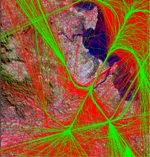Brisbane flight IT system saves fuel, bores pilots

Brisbane airport has finished trialling a flight system that helps planes keep precisely to a preordained flight path, which reduces aircraft carbon emissions by 650 tonnes, saves time, saves fuel, and reduces noise.

RNP approach paths (green) versus conventional flight paths (red) Credit: Airservices Australia
The software system, Required Navigation Performance (RNP), was developed by Airservices and US-based procedure design company Naverus, to run on the organisation's existing hardware. It uses the aircraft's flight management system to integrate data from different sources on the position of the aircraft to keep the plane strictly to its predetermined route.
During the pilot phase, 33 Qantas 737-800 aircraft flew over 15,500 routes between January 2007 and January 2008. The aircraft were required to navigate within 556 metres of a prescribed path, 95 percent of the time -- a target that was achieved.
During the 12 month pilot, over 200,000 kg of fuel was saved by RNP approaches by cutting travel distance and continuous descent approaches (CDA) -- where the aircraft drops constantly without levelling out during its descent -- according to Airservices Australia.
Flight paths for RNP (green) and Non-RNP (red) aircraft approaching Brisbane runway Credit: Airservices Australia
CDAs are not only more fuel efficient, but also help air traffic controllers predict the progress of aircraft, helping to better slot-in incoming planes.
Following the flight path is easy for pilots, according to an Airservices spokesperson: "The aircraft more or less fly themselves and it's incredibly accurate. The pilot could conceivably sit there with their arms folded -- but they wouldn't, of course."
Among the thousands of RNP flights, there were only five problems, which the Airservices Australia spokesperson said were minor events involving things such as the trajectory not being programmed in correctly.
The next stage of the trial will include the Jetstar A320/A321 and Air Vanuatu 737NG fleets, followed in 2009 by Virgin Blue Airlines and other international carriers with additional aircraft types.
Airservices and Naverus will deploy RNP across Australia. It is already being used in Alice Springs, Canberra, Townsville, Ayers Rock, the Gold Coast and to some extent in Sydney. The intention is to roll it out to all major airports, but a timeline has not been set.
In Australia, over 60 percent of the domestic jet fleet is RNP capable, while those aircraft not currently capable could potentially be retrofitted.
RNP helps reduce fuel consumption, emissions and noise by cutting the distance which the aircraft has to fly in a straight line before reaching the runway. Having curves in the approach allows the aircraft to avoid noise sensitive areas and reduce flight distance.
Air traffic management is receiving a lot of attention at the moment, with part of Europe's 1.6 billion euro Clean Sky initiative funding the development of fuel-efficient flight trajectory systems. The new systems will also allow the aircraft safety distance to be reduced according to Clean Sky participant Saab.